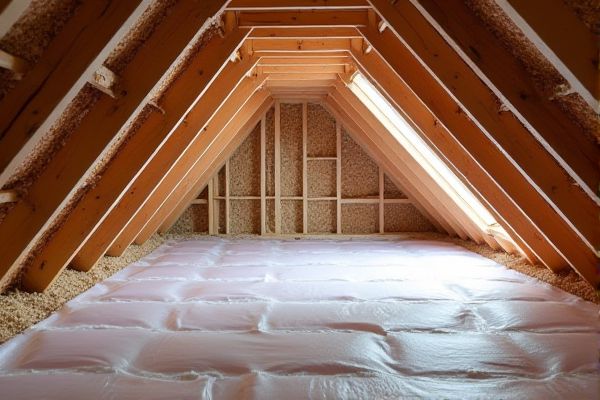
A vapor barrier prevents moisture from entering your attic, protecting insulation and structural components from mold and rot, while a radiant barrier reflects heat away to keep your attic cooler and reduce energy costs. Discover how choosing the right barrier can improve your home's comfort and efficiency by reading the rest of this article.
Table of Comparison
| Feature | Vapor Barrier | Radiant Barrier |
|---|---|---|
| Primary Function | Prevents moisture vapor from penetrating walls and ceilings | Reflects radiant heat to reduce heat gain in attics |
| Material | Plastic sheets (polyethylene), foil, kraft paper | Aluminum foil-faced material or reflective coatings |
| Installation Location | Installed on warm side of insulation (inside walls or ceilings) | Installed on attic rafters or roof decking |
| Primary Benefit | Controls moisture to prevent mold and structural damage | Reduces cooling costs by reflecting radiant heat |
| Effectiveness Climate | Critical in cold and mixed climates | Most effective in hot, sunny climates |
| Installation Impact | Requires proper sealing to be effective | Requires air gap for reflective performance |
| Cost | Low to moderate | Moderate |
| Energy Savings | Indirect by preventing moisture-related damage | Direct by reducing attic heat gain up to 30% |
Introduction to Attic Barriers
Vapor barriers and radiant barriers serve distinct purposes in attic insulation, with vapor barriers primarily controlling moisture diffusion to prevent mold and structural damage, while radiant barriers reflect radiant heat to reduce cooling costs. Understanding the difference between these attic barriers is crucial for optimizing your home's energy efficiency and indoor air quality. Choosing the right barrier depends on your climate, attic construction, and specific insulation goals.
What Is a Vapor Barrier?
A vapor barrier is a material designed to prevent moisture from passing through walls, ceilings, and floors, commonly used in attics to protect insulation and structural components from dampness. Unlike radiant barriers that reflect heat to improve energy efficiency, vapor barriers control humidity levels by blocking water vapor migration, helping avoid mold and wood rot. Understanding the difference between vapor and radiant barriers ensures Your attic insulation maintains effectiveness and longevity in various climates.
What Is a Radiant Barrier?
A radiant barrier is a reflective material installed in attics to reduce heat transfer by reflecting radiant heat away from living spaces, improving your home's energy efficiency. Unlike vapor barriers that control moisture and prevent condensation, radiant barriers focus specifically on minimizing heat gain during hot weather. Installing a radiant barrier can lower cooling costs by keeping attic temperatures cooler and enhancing overall indoor comfort.
Key Differences: Vapor Barrier vs Radiant Barrier
Vapor barriers are designed to prevent moisture from penetrating insulation and structural elements, controlling humidity and reducing the risk of mold in attics. Radiant barriers reflect radiant heat away from living spaces, significantly lowering attic temperatures and reducing cooling costs during hot weather. Unlike vapor barriers that address moisture control, radiant barriers primarily improve energy efficiency by minimizing heat transfer.
How Vapor Barriers Work in Attics
Vapor barriers in attics function by blocking moisture movement from the living space below into the attic, preventing condensation that can lead to mold growth and structural damage. These barriers are typically installed on the warm-in-winter side of insulation to inhibit water vapor from penetrating insulation materials and wood framing. Properly installed vapor barriers maintain indoor air quality and protect the attic's thermal integrity by controlling moisture accumulation effectively.
How Radiant Barriers Function in Attics
Radiant barriers in attics function by reflecting radiant heat away from your living space, significantly reducing heat gain during hot months and improving energy efficiency. Unlike vapor barriers that control moisture by limiting water vapor transmission, radiant barriers focus on minimizing thermal radiation through reflective surfaces, typically aluminum foil. Proper installation of radiant barriers can reduce attic temperatures by up to 30degF, lowering cooling costs and enhancing overall home comfort.
Best Situations for Each Barrier Type
Vapor barriers excel in humid climates where moisture control is critical to prevent mold and structural damage by stopping water vapor from entering insulation and attic spaces. Radiant barriers perform best in hot, sunny regions by reflecting radiant heat away from the attic, reducing cooling costs and enhancing energy efficiency. Selecting the appropriate barrier depends on the local climate: vapor barriers are ideal for moisture-prone areas, while radiant barriers are suited for homes in warm climates looking to minimize heat gain.
Installation Considerations for Attic Barriers
Proper installation of vapor barriers in attics requires sealing seams and edges to prevent moisture infiltration, which helps avoid mold and structural damage in your home. Radiant barriers should be installed with an air gap facing the reflective surface to maximize heat reflection and improve energy efficiency during hot months. Both barriers demand careful placement around insulation and ventilation components to maintain attic airflow and effectiveness.
Impact on Energy Efficiency and Comfort
Vapor barriers prevent moisture infiltration in the attic, reducing the risk of mold and structural damage while maintaining indoor air quality and insulation effectiveness. Radiant barriers reflect radiant heat away from living spaces, significantly lowering attic temperatures and reducing cooling costs during hot months. Combining both barriers optimizes energy efficiency by controlling moisture and heat transfer, enhancing overall comfort and reducing HVAC load.
Choosing the Right Barrier for Your Attic
Choosing the right barrier for your attic depends on your climate and insulation needs. Vapor barriers prevent moisture buildup by blocking water vapor, which is essential in humid climates to avoid mold and structural damage. Radiant barriers reflect heat away from your attic, making them ideal for hot climates to reduce cooling costs and improve your home's energy efficiency.
 homyna.com
homyna.com